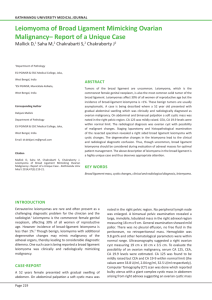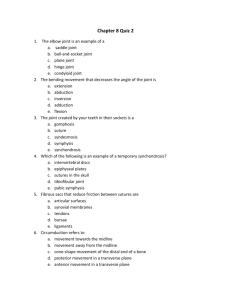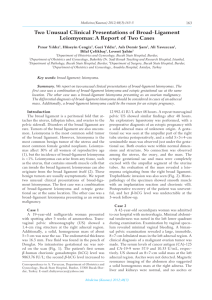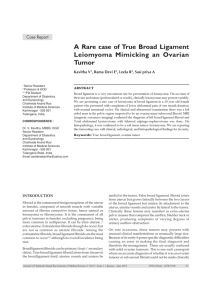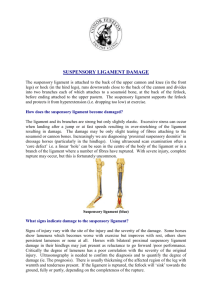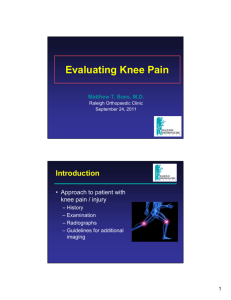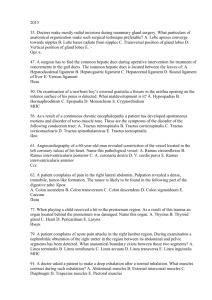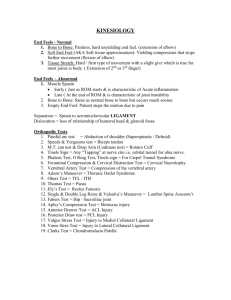Broad Ligament Leiomyoma Mimicking As Ovarian
advertisement
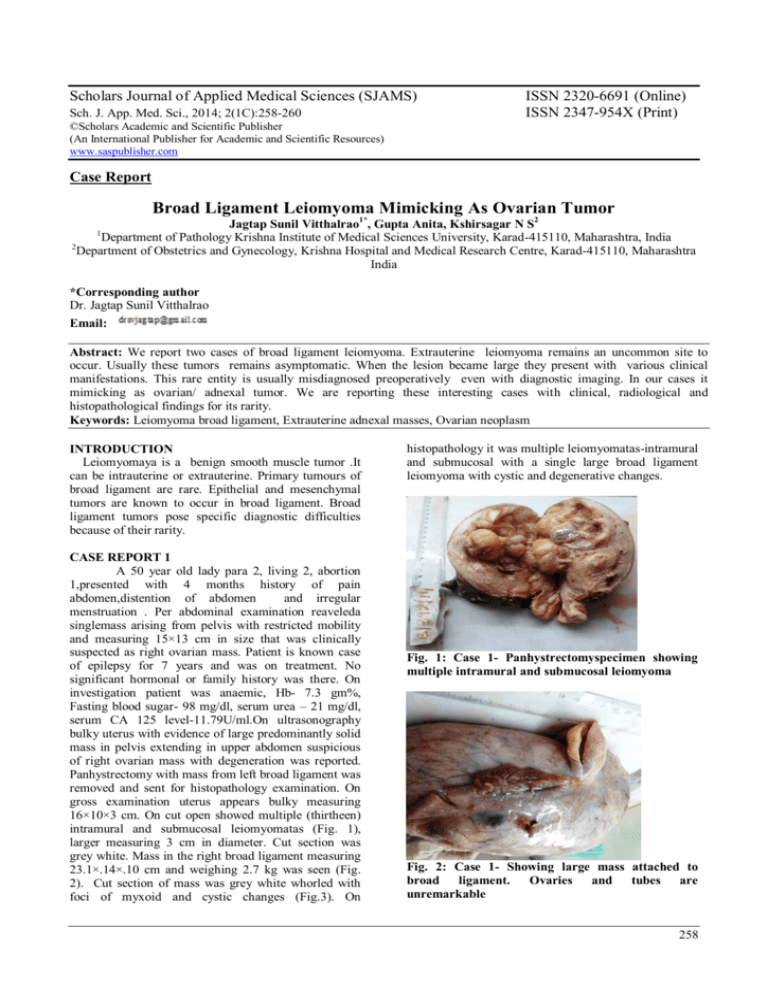
Scholars Journal of Applied Medical Sciences (SJAMS) Sch. J. App. Med. Sci., 2014; 2(1C):258-260 ISSN 2320-6691 (Online) ISSN 2347-954X (Print) ©Scholars Academic and Scientific Publisher (An International Publisher for Academic and Scientific Resources) www.saspublisher.com Case Report Broad Ligament Leiomyoma Mimicking As Ovarian Tumor Jagtap Sunil Vitthalrao1*, Gupta Anita, Kshirsagar N S2 Department of Pathology Krishna Institute of Medical Sciences University, Karad-415110, Maharashtra, India 2 Department of Obstetrics and Gynecology, Krishna Hospital and Medical Research Centre, Karad-415110, Maharashtra India 1 *Corresponding author Dr. Jagtap Sunil Vitthalrao Email: Abstract: We report two cases of broad ligament leiomyoma. Extrauterine leiomyoma remains an uncommon site to occur. Usually these tumors remains asymptomatic. When the lesion became large they present with various clinical manifestations. This rare entity is usually misdiagnosed preoperatively even with diagnostic imaging. In our cases it mimicking as ovarian/ adnexal tumor. We are reporting these interesting cases with clinical, radiological and histopathological findings for its rarity. Keywords: Leiomyoma broad ligament, Extrauterine adnexal masses, Ovarian neoplasm INTRODUCTION Leiomyomaya is a benign smooth muscle tumor .It can be intrauterine or extrauterine. Primary tumours of broad ligament are rare. Epithelial and mesenchymal tumors are known to occur in broad ligament. Broad ligament tumors pose specific diagnostic difficulties because of their rarity. CASE REPORT 1 A 50 year old lady para 2, living 2, abortion 1,presented with 4 months history of pain abdomen,distention of abdomen and irregular menstruation . Per abdominal examination reaveleda singlemass arising from pelvis with restricted mobility and measuring 15×13 cm in size that was clinically suspected as right ovarian mass. Patient is known case of epilepsy for 7 years and was on treatment. No significant hormonal or family history was there. On investigation patient was anaemic, Hb- 7.3 gm%, Fasting blood sugar- 98 mg/dl, serum urea – 21 mg/dl, serum CA 125 level-11.79U/ml.On ultrasonography bulky uterus with evidence of large predominantly solid mass in pelvis extending in upper abdomen suspicious of right ovarian mass with degeneration was reported. Panhystrectomy with mass from left broad ligament was removed and sent for histopathology examination. On gross examination uterus appears bulky measuring 16×10×3 cm. On cut open showed multiple (thirtheen) intramural and submucosal leiomyomatas (Fig. 1), larger measuring 3 cm in diameter. Cut section was grey white. Mass in the right broad ligament measuring 23.1×.14×.10 cm and weighing 2.7 kg was seen (Fig. 2). Cut section of mass was grey white whorled with foci of myxoid and cystic changes (Fig.3). On histopathology it was multiple leiomyomatas-intramural and submucosal with a single large broad ligament leiomyoma with cystic and degenerative changes. Fig. 1: Case 1- Panhystrectomyspecimen showing multiple intramural and submucosal leiomyoma Fig. 2: Case 1- Showing large mass attached to broad ligament. Ovaries and tubes are unremarkable 258 Jagtap Sunil V et al., Sch. J. App. Med. Sci., 2014; 2(1C):258-260 Fig. 3: case 1- Cut open specimen of leiomyoma showing grey white whorled appearance along with cystic change CASE REPORT 2 A 45 year old female para 2,living 2, abortion 0, presented with history of pain abdomen 1 month and irregular menstruation since last 6 months. No significant hormonal or family history was there. Per abdominal examination reaveled a single mass in left lowerabdomen. It was firm, smooth, non-tender,mobile and measuring 20×18 cm. Routine laboratory investigations were within normal limit. Serum CA 125 levels were raised (102.5 U/ml).On Ultrasonography a large solid echoic heterogenouslesion extending from pelvis (leftadenexa) upto the left hypochondriac region was noted. It showed few small cystic spaces within it. No obvious internal foci of calcification were seen. Left ovary could not be seen separately from the lesion. Free fluid was noted. Radiologically suspicious of left adnexal mass –ovarian tumor was given. Exploratory laprotomy with panhystrectomy with removal of large mass adherent to left broad ligament was done and sent for histopathology. On gross examination uterus, endometrium, ovaries were unremarkable. Left side broad ligament shows a single large circumscribed mass measuring 19.2×11.5×.7 cm and weighing 3.1 kg (Fig. 4). External surface showed congested blood vessels and nodularity. On cut section mass was grey white, firm with whorled appearance. A small thick stalk with blood vessel was seen attached to superiolateral part of the broad ligament. On histopathology it was diagnosed as leiomyoma with secondary changes of hyalinization and myxoid degeneration (Fig.5).There was focal areas showing increased cellularity. There was no evidence of necrosis and haemorrhage. Both the ovaries and endometrium were unremarkable. Fig. 4: Case 2- Panhystrectomy specimen with large mass arising from left broad ligament Fig. 5: Photomicrograph showing benign smooth muscle tumor with areas of myxoid change. (H & E stain, 100x) DISCUSSION Extrauterine leiomyoma is a benign smooth tumor. The uterine leiomyoma is most common benign solid pelvic tumors in women [1]. Uterine leiomyoma are present in about 80 % of all hysterectomy specimen [2].While extra uterine leiomyoma is very uncommon. Broad ligament leiomyoma can originate from the uterus and invade the broad ligament or it can originate from broad ligament itself. These benign tumors are usually asymptomatic. However if the leiomyoma reaches significant size, it can push uterus to contralateral side or it can potentially compress the surrounding pelvis structure and manifest clinically with various sign and symptoms.The location of tumors often determines the various symptoms [3]. It was important for any adnexal masses to discriminate between benign and malignant nature of the lesion in preoperative period for optimal patient management. The differential diagnosis for broad ligament leiomyoma includes masses from ovarian origin – benign or malignant, broad ligament cyst, lymphadenopathy and tubo-ovarian masses. In our cases on clinical and radiological investigation it was 259 Jagtap Sunil V et al., Sch. J. App. Med. Sci., 2014; 2(1C):258-260 suspicious of ovarian neoplasm. The serum levels of cancer antigen CA – 125 were done which is in normal range in case 1 and rose in case 2.Elevated cancer marker CA -125 levels may point to metastatic ovarian malignancies. But CA 125 is also raised in endometriosis, endometriomas, serous benign tumors and cystic teratomas [4] which make difficult to diagnose in preoperatively. Histopathology plays a important role in diagnosis for such cases. Leiomyomas may be single or multiple. In our case 1 there was multiple leiomyoma present in uterine cavity and one large on broad ligament. While in case2 it was a single mass in broad ligament without uterine leiomyoma. Broad ligament leiomyomas have the potential to grow to large size [5]. In our case also the tumor was of large size. When they grow large size secondary changes may occur. Most common secondary changes in leiomyoma are degeneration, infection, haemorrhage and necrosis. The cysticchanges in lesion mimic the metastatic malignant ovarian tumors [6]. Primary leiomyosarcoma in broad ligament is rarerly reported [7]. So, proper histopathological evaluation is important for patient management. CONCLUSION Extrauterine leiomyomas mimics ovarian tumors on clinical and radiological examination. Broad ligament leiomyoma should be kept important differential diagnosis for such solid adnexal or ovarian mass. REFERENCES 1. Neiger R, Sonek J, Croom C, Ventolini G; Pregnancy-related changes in the size of uterine leiomyomas". The Journal of reproductive medicine, 2006; 51 (9): 671–674. 2. Cramer SF, Patel A; The frequency of uterine leiomyomas. American Journal of Clinical Pathology, 1990; 94(4); 435-438. 3. Stewart EA; Uterine Fibroids. Lancet, 2001; 357(9252) : 293- 298. 4. Jacobs I, Bast RC Jr.; The CA 125 tumor associated antigen: a review of the literature. Hum Reprod., 1989; 4(1): 1-12. 5. Godbole RR, Laksmi KS, Vasant K; Rare case of giant broad ligament fibroid with myxoid degeneration. Journal of the Scientific Society, 2012; 39(3): 144-146. 6. RajannaDK, Pandey V, Janardhan S, Datti SN; Broad ligament fibroid mimicking as ovarian tumor on ultrasonography and computed tomography scan. J Clin Imaging Sci., 2013; 3:8. 7. Duhan N1, Singh S, Kadian YS, Duhan U, Rajotia N, Sangwan N; Primary Leiomyosarcoma of the broad ligament. A Case report and review of literature. Arch Gynecol Obstet., 2009; 279(5): 705-708. 260

